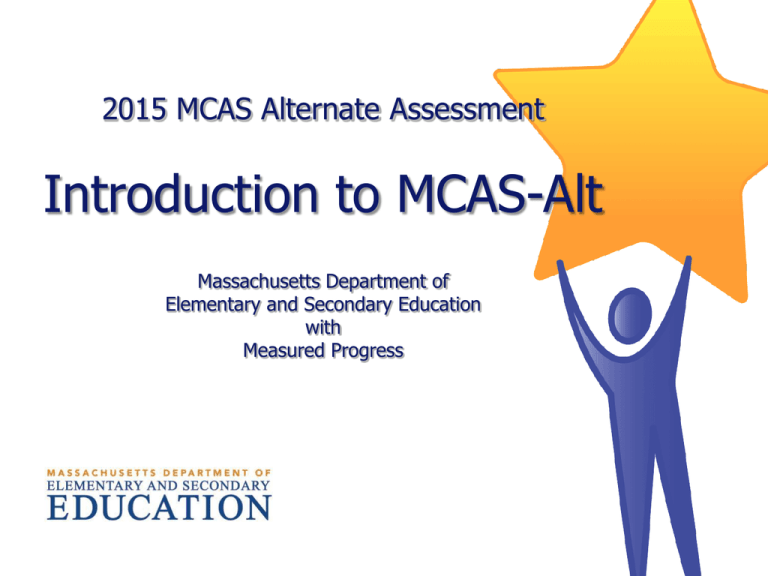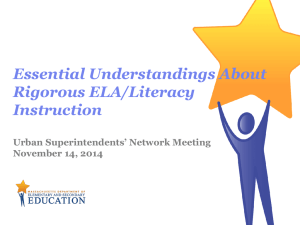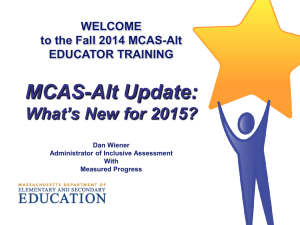PowerPoint - mcas
advertisement

2015 MCAS Alternate Assessment Introduction to MCAS-Alt Massachusetts Department of Elementary and Secondary Education with Measured Progress Welcome Introductions Department staff Teacher Consultants Measured Progress Training Specialists Goals for the session To provide you with tools and strategies for constructing the alternate assessment portfolio To help you to understand the alternate assessment process 2 How to link instruction to assessment Massachusetts Department of Elementary and Secondary Education Let’s Agree to: Eliminate distractions Cell phones, email, and internet Participate Minimize side chats, review all handouts Take care of your needs Coffee, breaks Parking Lot “I have a student who…” Massachusetts Department of Elementary and Secondary Education 3 4 Massachusetts Department of Elementary and Secondary Education Educator’s Manual, pp. 7–8 MCAS-Alt Security Requirements Your role is to ensure that evidence is: authentic and portrays student performance accurately. not replicated, altered, or fabricated. Evidence must reflect each student’s unique abilities and performance, regardless of participation in similar classroom activities. 5 ESE may request fact-finding investigation if irregularities are found or reported. Massachusetts Department of Elementary and Secondary Education Educator’s Manual pp. 9–10 “Who Should Take MCAS-Alt?” IEP team and 504 developers must decide annually in each subject whether the student… — Is generally unable to demonstrate knowledge and skills on a paper-and-pencil test, even with accommodations, AND — Is addressing learning standards that have been substantially modified due to the severity and complexity of their disability, AND — Receives intensive, individualized instruction in order to acquire and generalize knowledge and skills. If so, then he or she should take the MCAS-Alt in that subject. Yes, a student can take the standard test in one subject, and an alternate assessment in another. Massachusetts Department of Elementary and Secondary Education 6 Educator’s Manual, p. 11, 21—30 Other students who may benefit from the MCAS-Alt If a student with a disability is… — Addressing standards at or near grade-level, — Sometimes able to take a paper-pencil test with accommodations, — Presented with unique and significant challenges in demonstrating knowledge and skills on a test like the MCAS, and — Those challenges cannot be overcome using accommodations on the standard test, Then… 7 — Teams may consider the MCAS-Alt “Grade-level” (grades 3-8) or “Competency” (high school) portfolio. Massachusetts Department of Elementary and Secondary Education Educator’s Manual, p. 2 Alternate Assessments in districts that will administer PARCC in 2015 Students designated for alternate assessments in the 20142015 school year will continue to submit the MCAS-Alt portfolio, regardless of their districts’ choice to administer either MCAS or PARCC. 8 Massachusetts Department of Elementary and Secondary Education MCAS-Alt Terminology 9 Massachusetts Department of Elementary and Secondary Education What’s the “Buzz:” MCAS-Alt Terminology Content Area: The subject in which an MCAS-Alt portfolio is submitted; e.g., English Language Arts/Literacy (ELA), Mathematics, Science & Technology/Engineering (STE) Strand: A group of standards in ELA/Literacy and STE organized around a central idea, concept, or theme. (e.g., Writing, Life Science) Domain: A group of related standards in Mathematics organized around a central idea, concept, or theme. (e.g., Functions) Massachusetts Department of Elementary and Secondary Education 10 MCAS-Alt Terminology-cont’d Cluster: Smaller group of related standards (e.g., “Define, evaluate, and compare functions") Standard: Statement of what all students should know and be able to do. (e.g., 8.F.A.1 – Understand that a function is a rule that assigns to each input exactly one output.) Entry Points: Outcomes described in the Resource Guide that are based on a learning standard at lower levels of complexity or difficulty. Entry points will be the base for the measurable outcome. Access Skills: Developmental (communication or motor) skills that are addressed during standards-based academic activities in the content area being assessed. Massachusetts Department of Elementary and Secondary Education 11 MCAS-Alt Terminology-cont’d Measurable Outcome: A specific goal based on an entry point in the strand/domain required for assessment of a student in that grade. A measurable outcome identifies an acceptable skill to be assessed. Portfolio evidence in each portfolio strand documents the student’s performance of the measurable outcome. (e.g., “Student will sort 3-dimensional shapes by attribute with 80% accuracy and 80% independence”) Resource Guide: Curriculum guide used to determine 12 instruction for students with disabilities based on the Massachusetts Curriculum Frameworks. Massachusetts Department of Elementary and Secondary Education Access to Your Digital Resources 13 Massachusetts Department of Elementary and Secondary Education Flash Drive Tablets www.mcas-alt.org/materials open PDF version of document “Open in” iBooks to save Laptops/computers Windows- My Computer> find drive with flashdrive MAC- Desktop >flashdrive “MCAS-ALT” Massachusetts Department of Elementary and Secondary Education 14 2015 MCAS-Alt Flash Drive www.mcas-alt.org/materials 15 Massachusetts Department of Elementary and Secondary Education Flash Drive You Received Today Includes: 2014 Resource Guides (Updated) ELA and Literacy Math including High School Science and Tech/Eng (Grades 5,8, 9 or 10) 2015 Educators’ Manual PowerPoint Presentations Math Glossary ELA Glossary Literature and Informational texts author list Massachusetts Department of Elementary and Secondary Education 16 Quick Tips • Search Text • Highlight • Comment 17 Massachusetts Department of Elementary and Secondary Education Resource Guide to the Massachusetts Curriculum Frameworks for Students with Disabilities Used as the basis for identifying skills to be assessed in the MCAS-Alt portfolio Intended for use by educators to align and develop instruction for students who have not yet mastered the performance expectations of their peers Outlines a progression of skills from grade-level to less complex (high-, medium-, and low-complexity) for each grade-level learning standard based on the Curriculum Frameworks Massachusetts Department of Elementary and Secondary Education 18 Sometimes, It Seems Like This…. Learning Standards 19 Massachusetts Department of Elementary and Secondary Education …It Could Be More Like This… Learning Standards Grade Level Entry Points Access Skills 20 Massachusetts Department of Elementary and Secondary Education Educator’s Manual p.34 Based on 2011 Curriculum Framework: Standards, Entry Points, Access Skills “Essence” of standard: Solve mathematical problems involving 3-D shapes Visually track geometric shapes Access Skills Less Complex Match same shapes with different orientations Sort twodimensional shapes by attribute (e.g., number of sides) Entry Points Calculate the surface area of a cube H.G.-GMD.4 Identify the shapes of two-dimensional cross-sections of three-dimensional objects, and identify threedimensional objects generated by rotations of twodimensional objects. Standard as written More Complex Massachusetts Department of Elementary and Secondary Education 21 Features of the 2014 ELA Resource Guide Standards and Entry Points provide examples to illustrate and model the standard (“e.g., …”) Entry points are numbered to correspond with standard number If too complex, spiral to entry points in lower grades. Access skills are listed at the lowest grade in each strand For collecting evidence, use the student’s primary mode of expression (production), communication, and preferred method and format for presenting materials. Massachusetts Department of Elementary and Secondary Education 22 2014 Resource Guide: ELA Cluster Heading Standards 23 Massachusetts Department of Elementary and Secondary Education 2014 Resource Guide for ELA: Entry Points and Access Skills Cluster Heading Standard Number Access Skills Entry Points 24 Massachusetts Department of Elementary and Secondary Education 2014 Resource Guide for ELA: “Vocabulary Acquisition and Use” Standard Cluster Heading Grade 25 Massachusetts Department of Elementary and Secondary Education Features of the 2014 Mathematics Resource Guide Standards and Entry Points provide examples to illustrate and model the standard. If entry point is too complex, spiral to entry points in lower grades in the same domain, clusters may not match. For all grades, entry points must be used as is, to develop measurable outcomes. Access skills are listed at the lowest grade in a domain or a high school conceptual category 26 Massachusetts Department of Elementary and Secondary Education 2014 Mathematics Resource Guide Cluster Heading Standard Number 27 Standards Massachusetts Department of Elementary and Secondary Education 2014 Mathematics Resource Guide Example Cluster Heading Access Skills Entry Points 28 Massachusetts Department of Elementary and Secondary Education Features of the 2014 Mathematics HS Resource Guide High School Conceptual Categories Number and Quantity Algebra Functions Geometry Statistics and Probability If entry point is too complex, spiral to entry points in lower grades in the same conceptual categories. Access skills are listed at the lowest grade in a domain or 29 a high school conceptual category Massachusetts Department of Elementary and Secondary Education 2014 Mathematics HS Resource Guide Cluster Heading Standard Number 30 Standards Massachusetts Department of Elementary and Secondary Education 2014 HS Mathematics Resource Guide Cluster Heading Entry Points Access Skills 31 Massachusetts Department of Elementary and Secondary Education Features of the Science and Tech/Eng Resource Guide All entry points are acceptable skills for creating the measurable outcome. Standards are based 2001/2006 Curriculum Frameworks If entry point is too complex, spiral to entry points in lower grades in the same topic. Access skills are listed at the lowest grade at each topic. 32 Massachusetts Department of Elementary and Secondary Education Topic Grid for Science 33 Massachusetts Department of Elementary and Secondary Education 2014 Science and Tech/Eng Resource Guide Topic Standards Essence Massachusetts Department of Elementary and Secondary Education 34 Science and Technology/Engineering Entry Points Entry Points 35 Massachusetts Department of Elementary and Secondary Education Required Assessments in Each Grade 36 Massachusetts Department of Elementary and Secondary Education Educator’s Manual, pp. 13–19 English Language Arts and Literacy Progression of Strands from Pre-K Through High School ELA Resource Guide, p. 7 Grade Level Strands PK K 1 2 3 4 5 6 7 8 9-10 11-12 For MCAS-Alt, select one Reading skill for assessment from any strand marked below with a (), according to the student’s grade. Reading Literature Reading Informational Text (Grade 10 only) (Grade 10 only) Reading Foundational Skills Reading Literacy in History/Social Studies Reading Literacy in Science and Technical Subjects Assess choice of one entry point in: • Reading • Writing (Grades 4, 7, 10) • Language (“Vocabulary Acquisition and Use”) (Grade 10 only) (Grade 10 only) For MCAS-Alt, select one Writing skill for assessment from any strand marked below with a (), according to the student’s grade. Writing (Grade 10 only) Writing Literacy in History/Social Studies, Science, and Technical Subjects KEY = Assessed by MCAS-Alt (Grade 10 only) For MCAS-Alt, select one Language skill for assessment from standards 4, 5, or 6 (“Vocabulary Acquisition and Use”), according to the student’s grade. Language Speaking and Listening (Grade 10 only) Massachusetts Department of Elementary and Secondary Education 37 Mathematics Domains and the Grades in Which They Are Taught and Assessed Must be assessed in Grades 3-8 Choose 3 of the 5 Conceptual Categories for High School 38 Massachusetts Department of Elementary and Secondary Education Educator’s Manual, pp.13-15 Grade 3–5 MCAS-Alt Requirements Must be assessed in the following Strands/Domains Content areas A student in this grade One portfolio strand each in: o Reading o Language (Vocabulary Acquisition and Use) (i.e.,L.3.4,L.3.5,L.3.6) One portfolio strand each in: o Operations and Algebraic Thinking o Measurement and Data One portfolio strand each in: o Reading o Language (Vocabulary Acquisition and Use) (i.e., L.4.4,L.4.5,L.4.6) o Writing One portfolio strand each in: o Operations and Algebraic Thinking o Number and Operations-Fractions One portfolio strand each in: o Reading o Language (Vocabulary Acquisition and Use)(i.e., L.5 .4,L.5.5,L.5.6) One portfolio strand each in: o Number and Operations in Base 39 Ten o Number and Operations-Fractions English Language Arts 3 Mathematics English Language Arts Mathematics 4 5 English Language Arts Mathematics Science and Technology/Engineering (STE) may be done over 2 years One portfolio strand each in any three STE strands Massachusetts Department of Elementary and Secondary Education Educator’s Manual pp.16-18 Grade 6 –8 MCAS-Alt Requirements Must be assessed in the following A student in this grade Content areas Content areas English Language Arts One portfolio strand each in: o Reading o Language (Vocabulary Acquisition and Use) (i.e., L.6.4, L.6.5, L.6.6) 6 Mathematics English Language Arts 7 Mathematics English Language Arts 8 One portfolio strand each in: o The Number System o Ratios and Proportional Relationships One portfolio strand each in: o Reading o Language (Vocabulary Acquisition and Use) . (i.e., L.7.4, L.7.5, L.7.6) o Writing One portfolio strand each in: o Ratios and Proportional Relationships o Geometry One portfolio strand each in: o Reading o Language (Vocabulary Acquisition and Use)(i.e., L.8.4, L.8.5, L.8.6) One portfolio strand each in: o Expressions and Equations o Geometry Mathematics Science and Technology/Engineering One portfolio strand each in any three Massachusetts Department of Elementary and Secondary Education may be done over 2 years STE strands 40 Educator’s Manual p. 19 High School A student in this grade Must be assessed in the following Content areas 9 OR 10 3 standards in one of the following disciplines: o Biology o Introductory Physics o Chemistry o Technology/Engineering One portfolio strand each in: o Reading o Language (Vocabulary Acquisition and Use) (i.e.,L910 .4,L9-10.5,L.9-10.6) o Writing Any three of five Conceptual Categories : o Number and Quantity o Functions o Algebra o Geometry o Statistics and Probability Science and Technology/Engineering English Language Arts 10 Content areas Mathematics Massachusetts Department of Elementary and Secondary Education 41 Educator’s Manual p. 19 High School: Science and Technology/Engineering Grade 9 or 10 Evidence may be compiled over two consecutive school years in this subject. (7/1/13–4/2/15) Example of a discipline in high school STE: Biology 1 – Learning Standard 2.7 (Meiosis) Biology 2 – Learning Standard 6.4 (Ecology) Biology 3 – Learning Standard 5.1 (Evolution) 42 Massachusetts Department of Elementary and Secondary Education Educator’s Manual p. 33 “How will my student address the learning standards for the MCAS-Alt portfolio?” Students can address a standard in the required strand in several ways: • At the same level of difficulty as non-disabled students in that grade (“at grade-level”) If not, then… • At a lower level of complexity (i.e., below grade-level expectations) (“entry point”) If not, then… • Address an (“entry point” at a lower grade) If not, then… • Address a motor or communication “access skill” during a standards-based activity in the required strand Massachusetts Department of Elementary and Secondary Education 43 Educator’s Manual pp. 33,34,49 Access Skills For students with the most significant cognitive disabilities addressing a developmental skill. Students must practice the skill in the context of a standards–based activity in the required strand/domain assessed in the student’s grade. Possible approaches for students who do not produce written samples: Design instruction that does not require written product Scribe the student’s responses on a work sample (“teacher-scribed work sample”) Photograph or video the student performing the task (Consent needed) Massachusetts Department of Elementary and Secondary Education 44 Educator’s Manual p.61 Required Portfolio Elements Artistic Cover Portfolio Cover Sheet Student’s Weekly Schedule (Optional) School Calendar (holidays, summer school, snow days; previous year for Science, if applicable) Student’s Introduction to the Portfolio Verification Form (signed by parent; or log of attempts) Consent Forms for photo or video (Keep on file at school) Massachusetts Department of Elementary and Secondary Education 45 Educators Manual p. 33 “Core Set of Evidence” A complete Portfolio Strand must include at least the following evidence: Data Chart Strand Cover Sheet + showing performance of the measurable outcome on at least 8 different dates with brief descriptions + First piece of additional primary evidence* showing performance of the measurable outcome listed on data chart + Second piece of additional primary evidence* showing performance of the measurable outcome listed on data chart * May be a work sample, video segment, or photograph (or series of photos) clearly showing an end product. Evidence must be labeled with name, date, percent accuracy,46 and percent independence. Massachusetts Department of Elementary and Secondary Education Student Student 47 Massachusetts Department of Elementary and Secondary Education Sample Student Data Chart Student 48 Massachusetts Department of Elementary and Secondary Education Label: Name, Date, Accuracy, Independence, and Brief Description (required for each piece of evidence) Student Student 49 Massachusetts Department of Elementary and Secondary Education Student 50 Massachusetts Department of Elementary and Secondary Education Label: Name, Date, Accuracy, Independence, and Brief Description (required for each piece of evidence) Student 51 Massachusetts Department of Elementary and Secondary Education Work Sample Description label not required if the evidence is properly labeled 52 Massachusetts Department of Elementary and Secondary Education STORY CARDS 53 Supporting Documentation: Does not show actual performance or an end product, but gives clarifying information. Massachusetts Department of Elementary and Secondary Education Educator’s Manual p.39 Supporting Documentation Products that show or describe the learning context, but do not show actual performance or an end product: Photographs or videos that show setting, instructional approach, materials, etc., but not actual student performance Aids and supports used by the student 54 Massachusetts Department of Elementary and Secondary Education Student 55 Massachusetts Department of Elementary and Secondary Education Educator’s Manual pp.39,52 What is Self-Evaluation? Evidence of choices made by student; for example, that he/she has: Reflected on his or her performance Selected work for the portfolio Chosen materials/activities Set own goal for learning Graphed own performance Monitoring tasks accomplished on a checklist Used a scoring rubric to rate own performance Self-corrected work (as indicated by the teacher) Self-evaluation is done by the student, not by the teacher. Stickers on work are not examples of self-evaluation Massachusetts Department of Elementary and Secondary Education 56 More Examples of Self-Evaluation (Reflection) Student responded in writing to questions about the work he/she completed. Student used symbols to respond to questions about his/her work. 57 Massachusetts Department of Elementary and Secondary Education “Time” for a break 58 Massachusetts Department of Elementary and Secondary Education Portfolio Assessment Process 59 Massachusetts Department of Elementary and Secondary Education Educator’s Manual pp.33-37 Steps in Assessing Your Student 1. Identify the assessment requirements for a student in that grade (Educator’s Manual pp 13-19). 2. Identify a standard in the required strand at the grade level of the student (Resource Guide). 3. Pre-test to find the correct level of difficulty to begin assessing the student. 4. Identify an entry point (or access skill) for the standard (Resource Guide). 5. Create the measurable outcome from the selected entry point (or access skill), add criteria (e.g. 80% accuracy and 100% independence) 6. Collect and label evidence based on measurable outcome. Massachusetts Department of Elementary and Secondary Education 60 60 Educator’s Manual pp. 37–41 How to Identify a Skill to Assess Identify a strand required for MCAS-Alt Example: Biology (Resource Guide) Then, select one standard you feel is appropriate to teach your student Topic: Heredity, Standard 3.4, High School (Resource Guide, page 60): Distinguish among observed inheritance patterns caused by several types of genetic traits…. Review entry points, beginning with “more complex” “Describe how the cell’s genetic code is mapped in its DNA” (High School, page 61) “Sort characteristics that are inherited versus not inherited (determined by genetics)” (Grades 6-8, page 59) “ Identify parents and offspring of different species” (PreK-Grade 2, page 56) Massachusetts Department of Elementary and Secondary Education 61 Educator’s Manual pp. 37–41 How to Identify a Skill (cont’d) Based on pre-testing, what single skill should be targeted for assessment? Select the skill at the level of complexity that challenges the student. If too challenging for the student, adjust level downward. Describe how the cell’s genetic code is mapped in its DNA If student has already mastered, then not challenging enough, Identify parents and offspring of different species If challenging and attainable, then target the skill. Sort characteristics by inherited versus not inherited Once the correct level of complexity is established, begin collecting data and other evidence for the portfolio. Massachusetts Department of Elementary and Secondary Education 62 Measurable Outcome... Standards Entry point or Access Skills Instructional Activities (brief descriptions) …..identifies an acceptable skill to be assessed. Evidence in each portfolio strand documents the student’s performance of the measurable outcome. Massachusetts Department of Elementary and Secondary Education 63 The Measurable Outcome Should… Indicate what will be documented in the evidence. Be aligned with a grade-level learning standard at a level of complexity appropriate for the student. Be listed on the Strand Cover Sheet (line 5), data chart, and Work Sample Description labels. Remain consistent throughout the strand. All brief descriptions and evidence must document the same outcome. Allow students to progress toward mastery. Massachusetts Department of Elementary and Secondary Education 64 ELA Measurable Outcome: Language 65 Measurable Outcome: Student will sort words by categories with 80% accuracy and 100% independence Massachusetts Department of Elementary and Secondary Education Educator’s Manual p.3 ELA Measurable Outcome: Reading Reading = “Text Comprehension” Text comprehension includes the understanding of words, phrases, and sentences in the context of a text, rather than in isolation; and emphasizes applying, elaborating on, and generalizing information from a text, rather than simply recalling and recognizing information. For example, a list of idiomatic expressions matched to their meanings should not be included in the portfolio as evidence of text comprehension. Instead, students must identify the meaning of idiomatic expressions as they are used in a specific text. Massachusetts Department of Elementary and Secondary Education 66 Educator’s Manual p. 3 ELA Measurable Outcome: Reading Evidence and brief descriptions in the ELA Reading portfolio strand must identify either informational or literary text according to the strand chosen for assessment either by: the title of the published text, or a photocopy or printout of the text, if it is teachercreated, untitled or if it includes multiple selections from a digital source, (e.g. worksheets from teacher websites) or the actual text (e.g., sentence, passage, narrative, etc.) from which words, phrases, or excerpts were selected 67 Massachusetts Department of Elementary and Secondary Education ELA Measurable Outcome: Writing ELA Resource Guide emphasizes student’s primary mode of expression (production) and communication, and preferred method and format for presentation of materials. “…Using dictation, drawing, writing, or student’s primary mode of communication…” Resource Guide Example of Measurable Outcome in Writing: Student will order events to tell a story using pictures 68 with 90% accuracy and 100% independence. Massachusetts Department of Elementary and Secondary Education How does your student communicate? Oral language Sounds Symbols (photos, icons) Objects Gestures Sign language Eye gaze High tech device (e.g., Dynavox) Low tech device (e.g., communication book) Other? Massachusetts Department of Elementary and Secondary Education 69 Science and Technology/Engineering (STE) (Grades 5, 8 and 9/10) Entry points are acceptable as written Examples and descriptions on some entry points Massachusetts Department of Elementary and Secondary Education 70 Examples of Measurable Outcomes in Three Content Areas The student will… Identify the major stages of the life cycle of a butterfly…. Choose the most appropriate measurement tool to measure an associated object… Order simple fractions on a number line... Summarize a text using key details from a story read aloud… …with 80% accuracy and 100% independence. Are all of these skills observable and measurable? Massachusetts Department of Elementary and Secondary Education 71 Create a Measurable Outcome! Use the Resource Guide to locate an entry point or access skill for a student in your classroom(or a past student). Materials: Excerpt of the entry points from the 2014 Resource Guide or flash drive 2015 Educator’s Manual-“Required Assessment…”, PowerPoint or flash drive Create a measurable outcome based on the selected entry point Modify if needed, without altering essential meaning Add % of accuracy and independence required for mastery 72 Massachusetts Department of Elementary and Secondary Education Forms and Graphs 73 Massachusetts Department of Elementary and Secondary Education Where to find: Forms and Graphs Online: http://www.doe.mass.edu/mcas/alt/resources.html Registration for trainings in January and March Posted to www.doe.mass.edu/mcas/alt/resources under the heading Statewide Training www.mcasservicecenter.com 74 Massachusetts Department of Elementary and Secondary Education Forms and Graphs Available at: www.doe.mass.edu/mcas/alt/resources.html 75 Massachusetts Department of Elementary and Secondary Education Acceptable Digital Evidence for the Portfolio Submit separate CD, DVD, or flash drive for each student Acceptable digital evidence includes: • • • • • • PowerPoint Word document .pdf files .txt files .jpg (JPEG) DVD or standard movie formats Massachusetts Department of Elementary and Secondary Education 76 Technical Support By telephone (toll-free): 1-866-834-8880 (Measured Progress Tech Support) By email: TechProductSupport@measuredprogress.org When requesting support, have available: • Your name, school, and district • Your computer platform (Windows or Macintosh) • A summary of the problem you are experiencing Expect a response within 24 hours (or sooner). Massachusetts Department of Elementary and Secondary Education 77 Data Charts Educator’s Manual pp. 37-45 A Data Chart is Required in Every Strand Choice of Data Charts: Bar Graph, Line Graph, or Field Data Chart What to include on each: • Student’s name • Standard at the student’s grade level • Measurable Outcome aligned with Standard at grade level • Data points on at least different 8 dates showing accuracy and independence on each date • Brief, clear descriptions beneath each date (i.e., What was the student asked to do and how did he or she do it?) • Optional, but strongly encouraged: Include more than the eight date minimum. Massachusetts Department of Elementary and Secondary Education 79 Data Chart Requirements, cont’d Dates must be from current school year for ELA and Math (i.e., 7/1/14- 4/2/15), and current and/or one previous school year for Science and Tech/Eng (i.e., 7/1/13 - 4/2/15) Dates for classroom work must be when school is in session Not on a weekend, holiday, or during school vacations, unless marked “homework” 80 Massachusetts Department of Elementary and Secondary Education Educator’s Manual p. 88 Sample: Bar Graph Measurable Outcome At least 8 different dates are included on graph. Brief description of each data point that addresses the outcome listed above Massachusetts Department of Elementary and Secondary Education 81 81 Sample: Line Graph Educator’s Manual p.89 Measurable Outcome At least 8 different dates are included on graph. Brief description on each activity addresses what the student was asked to do and how they did it Massachusetts Department of Elementary and Secondary Education 82 Sample: Field Data Chart Educator’s Manual p.87 Measurable Outcome At least 8 different dates included Responseby-response data collection Brief descriptions on each data point addresses what the student was asked to do and how they did it Massachusetts Department of Elementary and Secondary Education 83 Educator’s Manual p.38 1. 2. 3. 4. How to Determine Accuracy and Independence Determine the outcome – What are you asking the student to do? Determine the activity – How will the student perform the skill? Divide the activity into “items” or steps – See example below Develop a system for marking each item – For example, +, —, I, P Sample Brief Description: Student answered five comprehension questions about a story read aloud in class. Question Number Accurate (Correct) or Independent or Inaccurate (+, —) Prompted (I, P) Question 1 + (Correct response) P (Verbal prompt) — (Incorrect response) P (Verbal prompt) Question 2 Question 3 + (Correct response) P (Gestural prompt) — (Incorrect response) P (Verbal prompt) Question 4 Question 5 + (Correct response) I (No prompt) Overall Percent 60% accuracy 20% independence (3 of 5 correct) (1 of 5 independent) Note: A student response using anyDepartment promptof = Not independent Massachusetts Elementary and Secondary Education 84 Educator’s Manual p. 35 Brief Descriptions must include: What did the student do? • what was the skill? How did the student perform the skill: •what instructional approach was used? •what materials (including text) was used? Measurable outcome: Student will create a rhyming couplet on a given topic with 80% accuracy and 100% independence. Brief description of activity: Student generated a rhyming couplet, about the topic summer, on the computer. WHAT HOW 85 Massachusetts Department of Elementary and Secondary Education Educator’s Manual p. 35 Brief Descriptions must : Document the same skill and any conditions present in the measurable outcome Measurable outcome: Student will multiply two-digit number by a two-digit number using an array or area model with 80% accuracy and 100% independence. WHAT Brief description of activity: Student solved 5 two-digit by two-digit multiplication problems, using student created arrays on the whiteboard. HOW Were all aspects of the measurable outcome met in the brief description? Would a scorer understand what the student did? Massachusetts Department of Elementary and Secondary Education 86 Acceptable Brief Descriptions Measurable Outcome: Walter will identify simple machines with 80% accuracy and 100% independence. Date (m/d/y) 9/12/14 10/15/14 10/17/14 10/24/14 11/4/14 11/14/14 11/20/14 What the Identified After student simple listening to did (skill) machines “Simple by Machines,” How did labeling identified they do pictures simple it? in an machines (approach, adapted in the materials) textbook book by pointing to correct name of simple machine Homework: Identified simple machines at home, made a list of the ones he found Worksheet identified inclined planes and levers as simple machines using pictures and text After watching video, Wheels and Axles, identified wheels and axles around the school Using Home Depot flyer, Walter identified levers and wedges using a bingo dauber After watching Eduhead on the computer, Walter identified inclined planes by matching them to the pictures in the video 12/5/14 Class created a poster of simple machines he identified the simple machines by labeling the poster with Post-it 87 Notes. Massachusetts Department of Elementary and Secondary Education Activity Are the following brief descriptions acceptable ? All measurable outcomes came directly from the Resource Guide. Measurable Outcome: Mary will answer simple comprehension questions about an informational text with 80% acc. and 100 % ind. (Reading Lit) Brief Description: Read chapter 1 from Fudge, summarized the main idea. Measurable Outcome: Pasqual will find the sum of the values of a mixed group of coins with 80% acc. and 100 % ind. (MD) Brief Description: Student used money to buy a soda. Measurable Outcome: Sophia will identify words that correspond to icons found in the environment with 80% acc. and 100% ind. (Lang.) Brief Description: Identified all the EXIT signs on the way to the bus by pointing. Measurable Outcome: Yi will distinguish between parallel and intersecting lines with 80 % acc and 100% ind. (G) 88 Brief Description: Worked on EDM during morning group with Miss Sue, pointed to parallel lines, 3/5 prompted. Massachusetts Department of Elementary and Secondary Education Activity Are the following brief descriptions acceptable ? All measurable outcomes came directly from the Resource Guide. Measurable Outcome: Mary will answer simple comprehension questions about an informational text with 80% acc. and 100 % ind. Brief Description: Read chapter 1 from Fudge, summarized the main idea Not Acceptable Measurable Outcome: Pasqual will find the sum of the values of a mixed group of coins with 80% acc. and 100 % ind. Brief Description: Student used money to buy a soda. Not Acceptable Measurable Outcome: Sophia will identify words that correspond to icons found in the environment with 80% acc. and 100% ind. Brief Description: Identified all the EXIT signs on the way to the bus by pointing. Acceptable Measurable Outcome: Yi will distinguish between parallel and intersecting 89 lines with 80 % acc and 100% ind. Brief Description: Worked on EDM during morning group with Miss Sue, pointed to parallel lines, 3/5 prompted. Not Acceptable Massachusetts Department of Elementary and Secondary Education Write a Brief Description Use the measurable outcome you created from the entry point or access skill Create 3 activities that would align with the measurable outcome Write brief descriptions that describe ‘what (skill) the student did and how (instructional approach and materials) they did it’ for each activity Do the brief descriptions address the measurable outcome? (6 minutes) Then, report out at your table. 90 Massachusetts Department of Elementary and Secondary Education Educator’s Manual, p. 54 Generalized Performance Documenting the use of different instructional methods and approaches during learning activities that assess the same skill = Generalized Performance For example, using the following to create evidence for the portfolio: Multiple-choice and open-response formats Verbal and written responses Varied media and materials (not only paper/pencil) Work completed in a community setting Notes: Different settings and people assisting the student do not, by themselves, demonstrate generalized performance, unless activity 91 format is also different. Massachusetts Department of Elementary and Secondary Education Portfolio Evidence Educator’s Manual, pp. 35–37 What Is Primary Evidence? Primary Evidence: Evidence that documents the student’s performance of the measurable outcome, including: • Data charts – bar or line graphs: one task or activity per date – field data charts: several tasks on each date, with percentages summarized for each date • Work samples – produced by student (or scribed by teacher), including digital evidence And, if they show the student’s actual performance: • Photographs that show an end product of instruction • Video segment (up to 3 minutes) Massachusetts Department of Elementary and Secondary Education 93 Educator’s Manual, pp.36-37 A Photograph is Primary Evidence When… It shows the end product of instruction or a sequence of steps leading to creation of the final product The work sample is either too large, fragile, temporary in nature, or unsafe to include in a portfolio Like work samples, photos must be labeled. The following information can be listed on the evidence OR on a Work Sample Description label: Student’s name Date % Accuracy and % Independence Brief description of the activity Massachusetts Department of Elementary and Secondary Education 94 Educator’s Manual, p. 35 A Series of Photographs = One Piece of Primary Evidence Student was asked to find a shape by the attribute. (round) Student’s response can be seen clearly. Student was asked to find a shape by the attribute. (straight sides) Student’s response can be seen clearly. Each series shows a two-step activity that was described and labeled correctly. [Student] December 12, 2014 Accuracy: 100% Independence: 100% Massachusetts Department of Elementary and Secondary Education 95 Can this Photograph be used as Primary evidence? NO! This does not meet the criteria to be used as primary evidence. This photo only shows the context of the learning activity, but not clear evidence of his/her responses. Massachusetts Department of Elementary and Secondary Education 96 Educator’s Manual, p.35 Video is Primary Evidence When… Student performs a task and no other tangible evidence can be collected It shows the end product of instruction (or a sequence of steps leading to the creation of the end product); OR It shows or describes a work sample that is either too large, fragile, temporary in nature, or unsafe to include in a portfolio Sample must be 3 minutes or less NOTES: Must include a brief description of the task or activity Sound quality must be clear, or be transcribed in writing. Massachusetts Department of Elementary and Secondary Education 97 Educator’s Manual, p. 37 Teacher-Scribed Work Sample • For students who do not produce written work • Documents a series of trials conducted at the same time • Indicates the student’s response (accuracy, independence) to each item/trial, using preferred mode of communication • Specifically describes the materials/context of the activity • Labeled with name, date, accuracy, independence, other information as needed. 98 Massachusetts Department of Elementary and Secondary Education Educator’s Manual, p. 37 Example of a teacher-scribed work sample A series of tasks recorded by the teacher on one date. 99 Massachusetts Department of Elementary and Secondary Education Important Reminders: Review the 2015 Educator’s Manual; Use only the most current Resource Guides; All Reading strands must provide name of a the published text or a copy; Data charts that begin at or above 80% in both accuracy and independence are not scorable; Entry points should be converted directly as is to create a measurable outcome, only minor modifications can be made. Outcomes not found in the resource guide must be preapproved by the Department. Massachusetts Department of Elementary and Secondary Education 100 Important Reminders: IMPORTANT: First date on chart must begin below 80% accurate or below 80% independent (or both) to show that a new skill was taught. Massachusetts Department of Elementary and Secondary Education 101 ELA Measurable Outcome: Reading Choose either a Literature or Informational Text Reading strand. All titles and photocopies of text must be consistent with the strand chosen. Measurable Outcome: Student will answer simple comprehension questions based on literature with 80% acc. and 80% ind.. Example of Brief Descriptions: 102 (author not necessary) Massachusetts Department of Elementary and Secondary Education Conditions in the Math Resource Guide 1. Are you using the most current Resource Guide? (Fall 2014) 2. Are there conditions listed in the entry point? Examples of Conditions: real-life examples, using manipulatives, visual model, arrays 3. Are the conditions necessary for the essence of the measurable outcome? • If yes, you must include them during instructional activities • If no, remove from the measurable outcome Example: Locate unit fractions on a number line. (entry point) Number line is a necessary condition. (review Number and Operations-Fractions standard 3.NF.A.2) 103 Massachusetts Department of Elementary and Secondary Education Using a Math Entry Point to Create a Measurable Outcome Option 1: Use Entry Point as written to create a Measurable Outcome: “Student will solve number sentences that represent one-step multiplication and division word problems with 80%accuracy and 100% independence” All work and all data points must show “solving number sentences involving multiplication and division” OR Option 2: Modify the Entry Point to meet your student’s needs: “Student will solve number sentences that represent one-step multiplication word problems with 80%accuracy and 100% independence” All work and all data points must show “solving number 104 sentences involving multiplication” Massachusetts Department of Elementary and Secondary Education Educator’s Manual p.53 Use of age-appropriate materials The examples below, and others like them, are inappropriate for use in student portfolios. Document respectful tasks that are meaningful and developmentally-appropriate. Massachusetts Department of Elementary and Secondary Education 105 Websites and Newsletter Resources and information: www.doe.mass.edu/mcas/alt/resources.html MCAS-Alt Newsletters 106 Massachusetts Department of Elementary and Secondary Education Portfolio Due Date: Portfolios must be picked up from the school by UPS on or before Thursday, April 2, 2015. Late portfolios will not be scored! Massachusetts Department of Elementary and Secondary Education 107 Contact Information: MA Dept. of Elementary and Secondary Education Daniel Wiener, Administrator of Inclusive Assessment Debra Hand, MCAS-Alt Program Specialist 781-338-3625 Email: dhand@doe.mass.edu Website: www.doe.mass.edu/mcas/alt/ Measured Progress Kevin Froton, Project Manager Email: froton.kevin@measuredprogress.org Tech Support for Forms and Graphs Online: (toll-free)1-866-834-8880 Register for training: www.mcasservicecenter.com Massachusetts Department of Elementary and Secondary Education 108








